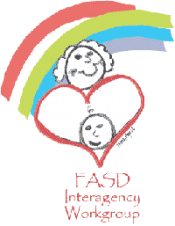What is the history of FASD?
In 1973, United States researchers first recognized and named fetal alcohol syndrome (FAS). Since that time, scientists have learned that any amount of alcohol consumed at any time during pregnancy can be harmful to the developing fetus. In 2005, the U.S. Surgeon General issued an Advisory on Alcohol Use in Pregnancy stating in part:
- Alcohol consumed during pregnancy increases the risk of alcohol-related birth defects, including growth deficiencies, facial abnormalities, central nervous system impairment, behavioral disorders, and impaired intellectual development.
- No amount of alcohol consumption can be considered safe during pregnancy.
- Alcohol can damage a fetus at any stage of pregnancy. Damage can occur in the earliest weeks of pregnancy, even before a woman knows that she is pregnant.
- The cognitive deficits and behavioral problems resulting from prenatal exposure are lifelong.
- Alcohol-related birth defects are completely preventable.
What is FASD?
The term FASD, or Fetal Alcohol Spectrum Disorders, is the term currently used to describe a group of birth anomalies that can result when a woman drinks alcohol while pregnant. These anomalies may be physical, developmental, or neurological. FASD is not a diagnostic term used by clinicians, rather it refers to conditions such as:
- Fetal Alcohol Syndrome (FAS), is recognized by growth deficiency, central nervous system damage, and a unique cluster of minor facial abnormalities (small eye openings, indistinct or flat philtrum, thin upper lip). FAS is one of the leading known causes of mental retardation and birth defects. If a woman drinks alcohol during her pregnancy, her baby can be born with FAS, a physically and mentally disabling condition. FAS is an irreversible, lifelong condition that affects every aspect of a child’s life and the lives of the child’s family. However, FAS is 100% preventable if a woman does not drink alcohol while she is pregnant.
- Partial FAS (pFAS), includes central nervous system damage and some, but not all of the growth deficiency and/or facial features of FAS.
- Fetal Alcohol Effects (FAE), a term introduced in 1978 to describe abnormalities seen in individuals that were compatible with those caused by prenatal alcohol exposure, but the pattern was not sufficiently complete to render a diagnosis of FAS. Some clinicians use the term ARND (see below) rather than FAE.
- Alcohol-related Neurodevelopmental Disorder (ARND), is diagnosed when the child has central nervous system damage and prenatal alcohol exposure.
- Static Encephalopathy, alcohol-exposed, is defined as any significant abnormal condition of the structure or function of brain tissues that are unchanging.
- Alcohol-related Birth Defects (ARBD).
The previous diagnoses are all Fetal Alcohol Spectrum Disorders. In 2004, several federal agencies and experts in the field convened at a summit sponsored by the National Organization on FAS (NOFAS) to develop a consensus definition of FASD. These experts defined "Fetal Alcohol Spectrum Disorders (FASD)" as an umbrella term describing the range of effects that can occur in an individual whose mother drank alcohol during pregnancy. These effects may include physical, mental, behavioral, and /or learning disabilities with possible lifelong implications. The term FASD is not intended for use as a clinical diagnosis.
Note: Canadian scientists have identified diagnostic criteria for FASD. Keep this in mind when reviewing materials on FASD from Canada.
What causes FASD?
FASD is caused by alcohol use during pregnancy. When a pregnant woman consumes alcohol, it crosses the placenta freely and enters the embryo or fetus and all of its developing tissues and organs. Defects caused by prenatal exposure to alcohol have been identified in virtually every part of the body, including the brain, face, eyes, ears, heart, kidneys, and bones.
Experts now warn that no alcohol consumption is safe during pregnancy. In addition, the type of alcohol consumed (beer, wine, hard liquor, wine cooler, etc.) does not appear to make a difference.
What is the prevalence of FASD?
According to the Fetal Alcohol Spectrum Disorders Center for Excellence (https://store.samhsa.gov/product/TIP-58-Addressing-Fetal-Alcohol-Spectrum-Disorders-FASD), FASD occurs in about 10 per 1,000 live births, or about 40,000 babies per year. FAS, the most recognized condition in the spectrum, is estimated to occur in 0.5 to 2 per 1,000 live births. It now outranks Down Syndrome and autism in prevalence.

